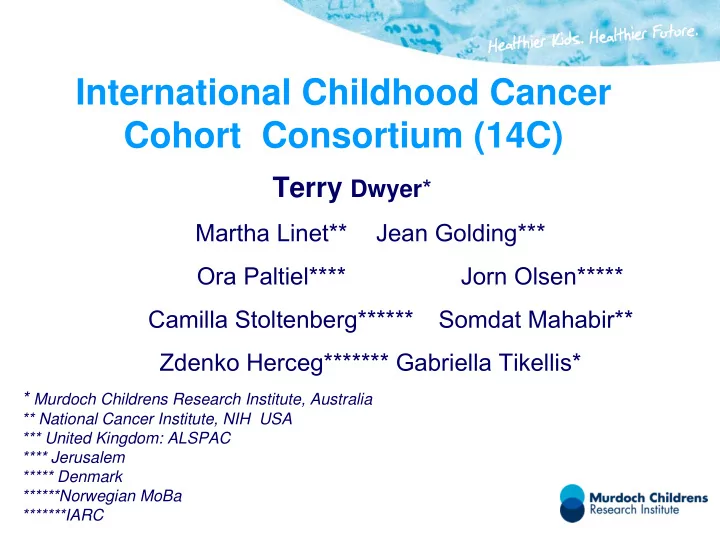

International Childhood Cancer Cohort Consortium (14C) Terry Dwyer * Martha Linet** Jean Golding*** Ora Paltiel**** Jorn Olsen***** Camilla Stoltenberg****** Somdat Mahabir** Zdenko Herceg******* Gabriella Tikellis* * Murdoch Childrens Research Institute, Australia ** National Cancer Institute, NIH USA *** United Kingdom: ALSPAC **** Jerusalem ***** Denmark ******Norwegian MoBa *******IARC
Data on human subjects is essential for gaining an understanding of the environmental causes of childhood cancer and adds great value to the genetic research
Case-control studies of the kind involved in the CLIC consortium are a central component of this work because they allow us to conduct studies with substantial power and focused measurement of exposures – cost-effectively
However in research on childhood cancer additional evidence from prospective cohort studies is highly desirable – to address concerns regarding recall bias and – to permit collection of biological specimens prior to disease onset Environmental chemicals Infections in childhood Birth weight
In childhood cancer, cohort studies have been difficult to mount because they need to be very large
Number of cases of cancer occurring in a cohort of 100,000 children followed from 0-14 For all cancers n = 242 56 77 ALL AML/other Lymphomas 15 CNS Other 26 68
Number needed to study leukemia (Acute Lymphoblastic Leukemia & Acute Myeloid Leukemia) Percentage Minimum Power % Number of subjects risk Required exposed detectable 5 1.5 80 1180059 15 1.5 80 446633 30 1.5 80 277781 Garcia-Closas M, Lubin JH. Am J Epidemiol. 1999 Age-adjusted SEER cancer incidence rates USA 1975-2002
No study of children in the world involves the necessary 1 million subjects. However, since 1990 a number of countries have commenced large infant/child cohort studies
Norwegian Mother & Child Cohort Study ‐ Norway 105,422 Danish National Birth Cohort – Denmark ALSPAC – UK 14,541 96,840 EFESE – France 20,000 Sino ‐ US CPBDDP – China National Children’s Study – USA 245,000 100,000 Tasmanian Infant Health Survey – Australia 10,627
Biological Childhood samples for Birth weight Environmental Folate infections genotyping etc and birth order exposures √ √ √ √ √ National Children’s Study √ √ √ √ √ Norwegian Mother and Child Study √ √ √ √ √ Danish National Birth Cohort √ √ √ √ √ Avon Longitudinal Study of Parents and Children √ √ √ √ √ Tasmanian Infant Health Survey X √ X √ √ Jerusalem Perinatal Study √ √ ? √ √ Collaborative Perinatal Project
Steering Steering Committee Committee Outside institutions Outside institutions Working Working • NCI • NCI • NICHD • NICHD Groups Groups • IARC • IARC International Data International Data Coordinating Centre Coordinating Centre (Murdoch Childrens Research (Murdoch Childrens Research Institute) Institute) Cohorts Cohorts
Data on 380,000 subjects has now been received at the IDCC.
Pooled analysis on 190,000 subjects: birth weight and child cancer POOLED DATA FROM TIHS, ALSPAC, CPP AND JPS 2: Case ‐ cohort analysis (Sept 8th 2011) Subcohort = 2323 ALL CHILDHOOD CANCER (N=130) ANY LEUKEMIA (N=33) ALL (N=25) and Birth weight (groups) and Birth weight (groups) and Birth weight (groups) HR (95%CI) HR (95%CI) HR (95%CI) UNADJUSTED <2500g 1.22 (0.67 ‐ 2.22) 0.82 (0.19 ‐ 3.44) 0.50 (0.07 ‐ 3.75) 2500 ‐ 3999 Ref Ref Ref 4000+ 1.63 (0.92 ‐ 2.91) 2.50 (0.96 ‐ 6.50) p=0.06 1.85 (0.55 ‐ 6.19) ADJ for GEST AGE <2500g 0.72(0.35 ‐ 1.48) 0.72 (0.12 ‐ 4.25) 0.39 (0.05 ‐ 2.98) 2500 ‐ 3999 Ref Ref Ref 4000+ 1.70 (0.90 ‐ 3.20) 3.16 (1.16 ‐ 8.63) p=0.025 2.33 (0.68 ‐ 7.99) ADJ for GEST AGE, SEX <2500g 0.74 (0.36 ‐ 1.52) 0.72 (0.12 ‐ 4.33) 0.41 (0.05 ‐ 3.12) 2500 ‐ 3999 Ref Ref Ref 4000+ 1.61 (0.85 ‐ 3.06) 3.04 (1.10 ‐ 8.38) p=0.03 2.12 (0.64 ‐ 7.06) ADJ for GEST AGE, MAT Diabetes* <2500g 0.62 (0.20 ‐ 1.92) 0.59 (0.05 ‐ 6.95) too small numbers 2500 ‐ 3999 Ref Ref Ref 4000+ 2.25 (1.10 ‐ 4.61) p=0.026 3.42 (1.12 ‐ 10.45) p=0.03 3.37 (1.03 ‐ 10.97) p=0.04 *n=6 ADJ for GEST AGE, MAT AGE <2500g 1.18 (0.57 ‐ 2.42) 0.73 (0.11 ‐ 4.76) 0.39 (0.05 ‐ 3.21) 2500 ‐ 3999 Ref Ref Ref 4000+ 1.91 (0.98 ‐ 3.73) p=0.057 2.86 (0.99 ‐ 8.28) p=0.052 2.02 (0.55 ‐ 7.43) ADJ for GEST AGE, PAT AGE <2500g 0.63 ( 0.27 ‐ 1.46) 0.64 (0.05 ‐ 7.50) too small numbers 2500 ‐ 3999 Ref Ref Ref 4000+ 1.40 (0.70 ‐ 2.77) 2.89 (1.01 ‐ 8.25) p=0.048 2.10 (0.59 ‐ 7.48)
Maternal prenatal smoking ALSPAC TIHS • 18 weeks gestation • One month postnatal G3. f) Did you smoke regularly at any of the following Q31: How much did you smoke during your pregnancy? times in the last 9 months? First 3 months of pregnancy, last 2 weeks. Cigarettes A B C • No Yes, cigarettes Yes, other 1 st Smoked 2nd 3rd Trimester Trimester Trimester (0-13 (14-27 (28-40 • 32 weeks gestation weeks) weeks) weeks) E3 How many cigarettes per day are you yourself smoking at the moment?........................cigarettes Nil 1-10/day 11-20/day 21-40/day Old_A New 41+/day Category Meaning Category Meaning score score* New Old_T 0 None 0 None Category Meaning Category Meaning 1 1 ‐ 4 1 1 ‐ 10 score score 2 5 ‐ 9 1 0 None 0 None 3 10 ‐ 14 2 11 ‐ 20 1 1 ‐ 10 1 1 ‐ 10 4 15 ‐ 19 2 2 11 ‐ 20 2 11 ‐ 20 5 20 ‐ 24 3 21+ 3 21+ 3 21 ‐ 40 6 25 ‐ 20 3 3 4 41+ 7 30+ 3 * New score=0 if type of smoking not cigarettes
I4C cohorts:Biospecimens TIHS ALSPAC BDSS ‐ DNBC MoBa CPP China √ √ √ √ X X Biospecimens – Mother Blood Biospecimens - Child √ √ √ √ Cord blood (1,000) X Guthrie PKU Guthrie cards X X X (n~520) 16
NCPS Package • The NCPS package comprises of 2 main parts: 1) An Excel Workbook 2) A Word document.
Recommend
More recommend